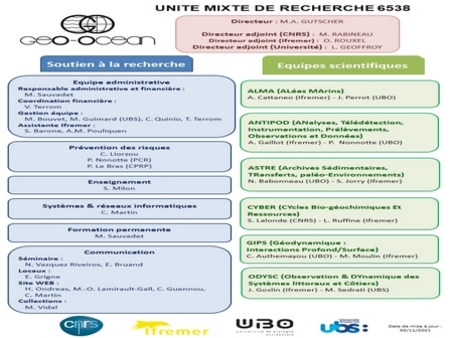Cobaltiferous crusts
In all oceans based massive rocky concretions, which can sometimes reach 25 cm thick and covering square miles of seabed. Overall, it was estimated that 6.35 million square kilometers, or 1.7 % of the ocean surface, are covered with what is colloquially called "crusts. They are found at depths ranging between 400 and 4,000 m depth, on seamounts and Isolated volcanic alignments, at elevations of underwater intra-plate, or in the coral formation of old submerged atolls.
- Potential mineral resources
- Genesis of cobaltiferous crusts
- Chemical composition
- Economic interest
- Technology exploitation
Crusts : potential mineral resources
The investigation actually started in 1981 in the central Pacific Ocean. It makes more than 20 years, many countries like Japan, the United States, Russia, France, Germany, Korea, the United Kingdom, China, are interested in these crusts, which are the subject of 42 campaigns between 1981 and 2000, the majority has been led by Japan for 15 years since 1985, in the Western Pacific. And because these rocky concretions contain many metals: iron, manganese, cobalt, etc... These are real minerals, resources potential.
The major "mining" is at the bottom of the Pacific Ocean. Among the 50,000 underwater volcanoes, we have explored only a few and discovered a treasure of rich deposits of cobalt and platinum that France is happy to be a heir. Indeed, the richest deposits lie in Polynesia, especially in the «French economic waters». The most valuable samples that we have collected from scabs sometimes ongoing at the outer edges of underwater plateaus such as the Tuamotu Archipelago, and volcanoes at depths ranging between 800 and 2500 meters.
Genesis of cobaltiferous crusts
It is now accepted as concretions called "cobaltiferous" begin to be formed from ferrous ions Fe 2+ and Mn 2+ manganese ions present in seawater, which precipitate as oxides of iron and manganese, in association with oxidation processes.
The growth of crust takes place very slowly, about 1 to 6 mm per million years, leaving time for metals, including cobalt, and platinum, it focused heavily, leading to thick crusts whose ages may reach 60 million years. The solid compounds obtained are then filed on solid substrates of seafloor volcanic or limestone.
Currently, we consider that all of these crusts constituent metals from seawater Moreover, it was found that the growth of crusts is enhanced when the oxygen content of sea water is minimal. It is likely that precipitation processes are also influenced and enhanced by bacterial activity ... These hypotheses must be explored and discussed from field data. Indeed, we found several microspheres of meteoric origin in certain areas. They contain nickel, cobalt and platinum in high quantity. A quick calculation shows however, that their contribution does not reflect high levels of cobalt and platinum in crusts ...
On the scientific level, efforts are still needed to better understand the distribution rules, the variability of thickness and composition and the various processes involved in the formation of these crusts.
Chemistry
Thus, as the polymetallic nodules, crusts are mainly composed of iron oxide and manganese. They are however on average three times as rich in cobalt and could be the first ore of this metal, so we called them a "cobaltiferous". They contain even more of cobalt ores exploited land (2-3 times in laterites where the content never exceeds 0.1 to 0.2% to a record 1.8% cobalt content in crusts Polynesia. It is considered that a site was "potentially economic" where concentrations of cobalt are above 1%, and this, in crusts with at least 5 cm thick and with a certain continuity of relatively flat surfaces.
Economic interest
Cobalt is so far a "by-product" of the extraction of other metals. But it is now in high demand and production has doubled between 1999 and 2006. It is mainly used to produce special steels for new technologies, especially alloys for aviation and batteries. About one third of the production of cobalt is used in the aerospace industry.
The second advantage of crusts is platinum that is often found very concentrated. This metal, very abundant on some sites, could also be a significant byproduct. He is wanted in particular by the catalyst industry (exhaust systems and fuel cells).
Finally, the crusts are a potential source of many other metals such as titanium, cerium, nickel, thallium, tellurium, zirconium, tungsten, bismuth or molybdenum.
Technology exploitation
The challenge for crust mining for cobalt and platinum are real. But at what price and with what technology? There are not many field data and calculation: geological controls wealthy areas, continuity of deposits, bottom friction, the influence of bedrock on the dilution pickup, etc ...
To date no field study has been carried out by diving on such deposits on the ocean floor ... but American projects are underway around Hawaii.







